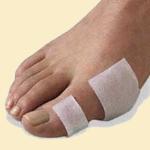« Seperating Boot Soles Repair | Main | Ha’ Apai Islands, Tonga »
How You Can Prevent and Deal with Blisters
By Editor | January 31, 2008
If you go camping and hiking chances are you are going to get some kind of blisters. There are many contributing factors to why you get blisters, here are a few:
– Pressure
– Friction
– Wet Socks
– Poor shoe/boot fitting
All of the above combine to rub and irritate your skin to create blisters. To protect and prevent the skin on your toes and heels follow these tips.
 1. Best offense is defense. As soon as you feel the burning on your skin, cover the spot with moleskin or duct tape.
1. Best offense is defense. As soon as you feel the burning on your skin, cover the spot with moleskin or duct tape.
2. You need to buy a lighter hiking boots, with gentler flexible uppers that are not as tough on your feet.
3. One of the best ways to prevent getting blisters is wearing boots that fit well. A boot the prevents heal slippage and gives your toes some room for movement are well recommended.
4. Break-in your new shoes or boots properly before going on a long hiking trip. Wear the new boots around the house, and on some short day hikes to get leather or material to soften up a bit. This also gives the boots a chance to conform to your foot shape.
5. Try wearing silk or polypro liners under your socks to minimize friction. In this case friction would only occur between the sock layers instead of your skin. Wool and Synthetic socks is highly recommended, if you don’t wear a liner because wool and some sythetics helps wick moisture away.
To treat the blisters on your toes and heels once you have gotten them follow these tips.
1. Change the bandage every 3 days. Wash and disinfect the area first before applying another bandage. If the area is swollen red or excreting pus, keep bandage on. If it persist you will need to see a doctor.
2. Pop the blister before it breaks on its own inside your moist, dirty socks. Clean the area first, then pierce the peak of the blister with a sterile needle (burn it with match first). Lightly push the puss from the edges of the blister out the hole. Then bandage.
3. If you are using a piece of moleskin or foam over top of your blister to prevent it from getting worse. Cut a hole in the moleskin or foam just larger than the blister in question, then put antibiotic ointment , then clean and dry the area around the blister. Next after 10 seconds replace the moleskin so that the hole is around the blister creating a pressure-free area, then put another piece of moleskin over it. This creates a pocket with no pressure allowing your blister to heal. Use duct tape or athletic tape if needed to secure the whole area.
Bookmark at:
StumbleUpon | Digg | Del.icio.us | Dzone | Newsvine | Spurl | Simpy | Furl | Reddit | Yahoo! MyWeb
Topics: Articles, Outdoor First Aid | Comments Off on How You Can Prevent and Deal with Blisters



